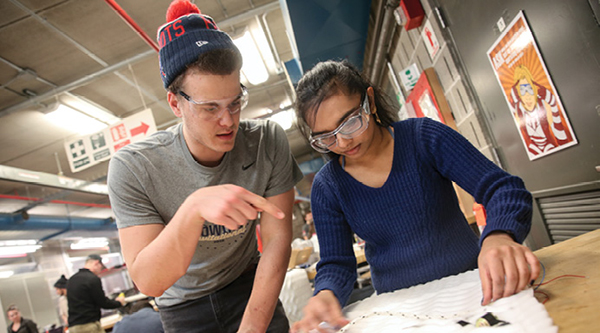Competition Embodies Spirit of “the New Polytechnic”
The Department of Mechanical, Aerospace and Nuclear Engineering at Rensselaer Polytechnic Institute (RPI) hosts a student design competition to help students explore how to develop "creative solutions to real-world problems."

Students collaboratively design devices to improve the lives of people with disabilities. Image courtesy of RPI.
Latest News
May 1, 2019
The Department of Mechanical, Aerospace and Nuclear Engineering (MANE) at Rensselaer Polytechnic Institute (RPI) hosts a student design competition: the Engineering Innovation for Society competition. The group is gearing up for the second year of competition and expects to turn it into an annual event.
RPI says it’s a “way to give students the opportunity to explore how engineering is used to develop creative solutions to real-world problems.” It provides an opportunity for students to adopt the entrepreneurial and collaborative spirit of what they call: “The New Polytechnic,” or the driving model for teaching, learning and research at Rensselaer.
Dr. John Tichy is professor, Mechanical Aerospace and Nuclear Engineering, at RPI. We spoke to Dr. Tichy to learn more about this competition. Here’s our conversation:
Digital Engineering: Can you provide an overview of the Engineering Innovation for Society competition, how it came to be and the intent of the program? Who will be participating or who have participated? How many participants have you had or are you expecting? Any demographics of participants?
Dr. John Tichy: The Engineering Innovation for Society competition challenges undergraduate students from top engineering schools across the Northeast to design new devices to help improve the lives of those with disabilities. [It’s] a goal that also fits within Rensselaer’s mission to change the world.
The competition is a partnership with the Center for Disability Services. The Center provides real-world scenarios that the teams must find solutions for. Eight teams of four students [each] compete. The first competition was last year. The plan is to hold the second [competition] next year.
There are a lot of hacking competitions, and there are a lot of intercollegiate competitions out there that have attracted attention. We wanted to find one for us in a niche in which we think we excel and that could grow into something bigger. There are similar competitions within a given university—there are a lot of interuniversity hackathons—but for the most part [these have] a computer science kind of flavor. So we wanted to have an intercollegiate competition with a mechanical flavor.
DE: Can you tell us about some of the designs that are part of the event and how they came to be?
Tichy: The Center for Disability Services provides the real-world challenges for the students to tackle. Most of what they do is one-of-a-kind in nature. For the most part, these are problems that impact the people they work with. Each problem was kind of new and unique in itself, so students would come up with interesting solutions.
DE: Can you provide some examples of what the event has produced or what you expect it to produce?
Tichy: The people from the Center were really great at explaining, in a passionate way, the nature of the problems that arose. The first thing the students had to do to come up with a good solution was to see the world through the client’s eyes. That was, I thought, really interesting. I think a lot of them walked away from it feeling enriched from that alone.
The teams came up with a number of solutions, like a device to get people from a wheelchair into a vehicle without being exposed to inclement weather; a writing instrument for people with Parkinson’s; a hand splint to help someone with cerebral palsy open their hand; and a special chair for individuals with autism.
DE: Does the Engineering Innovation for Society have a particular stance on adopting an innovation that is linked to the program? What drove them to sponsor the event and coordinate it?
Tichy: One of the things we’ve talked about, but haven’t done yet is take a winning design or two and go with it and see what it would take to make a true beta device and then make such a device with an eye to patent it and develop a viable product.
DE: Anything else you’d like to tell us about the event that the above questions haven’t given you opportunity to express?
Tichy: This experience gave students the opportunity to learn how to work in a team; how to think on their feet; how to design on the fly; and how to use available tools, such as design software, 3D printing and standard machine shop [workflows]. It also allowed students to appreciate just how complicated design can be, especially real-world mechanical design.
In addition, the students had an opportunity to exercise empathy by experiencing the passion people at the Center have for their work, [which is] the caring for others. It was an opportunity for engineers to gain a type of real-world knowledge I don’t think they could have gotten [this] any other way.
Subscribe to our FREE magazine, FREE email newsletters or both!
Latest News
About the Author
Jim Romeo is a freelance writer based in Chesapeake, VA. Send e-mail about this article to [email protected].
Follow DE





